Taxation Law Assignment: CGT, Income, and Assessable Income Analysis
VerifiedAdded on 2023/04/03
|8
|2026
|433
Homework Assignment
AI Summary
This document presents a comprehensive solution to a taxation law assignment, addressing key aspects of the Australian income tax system. The assignment analyzes capital gains tax (CGT) consequences arising from various transactions, including the sale of collectable assets like paintings and sculptures, and the implications of pre-CGT assets. It delves into the determination of assessable income, examining whether receipts from activities like book writing and selling manuscripts constitute income by personal exertion or capital receipts. The solution further explores the tax implications of loans and interest payments between individuals. Through detailed analysis and referencing relevant legislation, the assignment provides a clear understanding of taxation principles and their application to real-world scenarios, helping students grasp the intricacies of the Australian tax system.
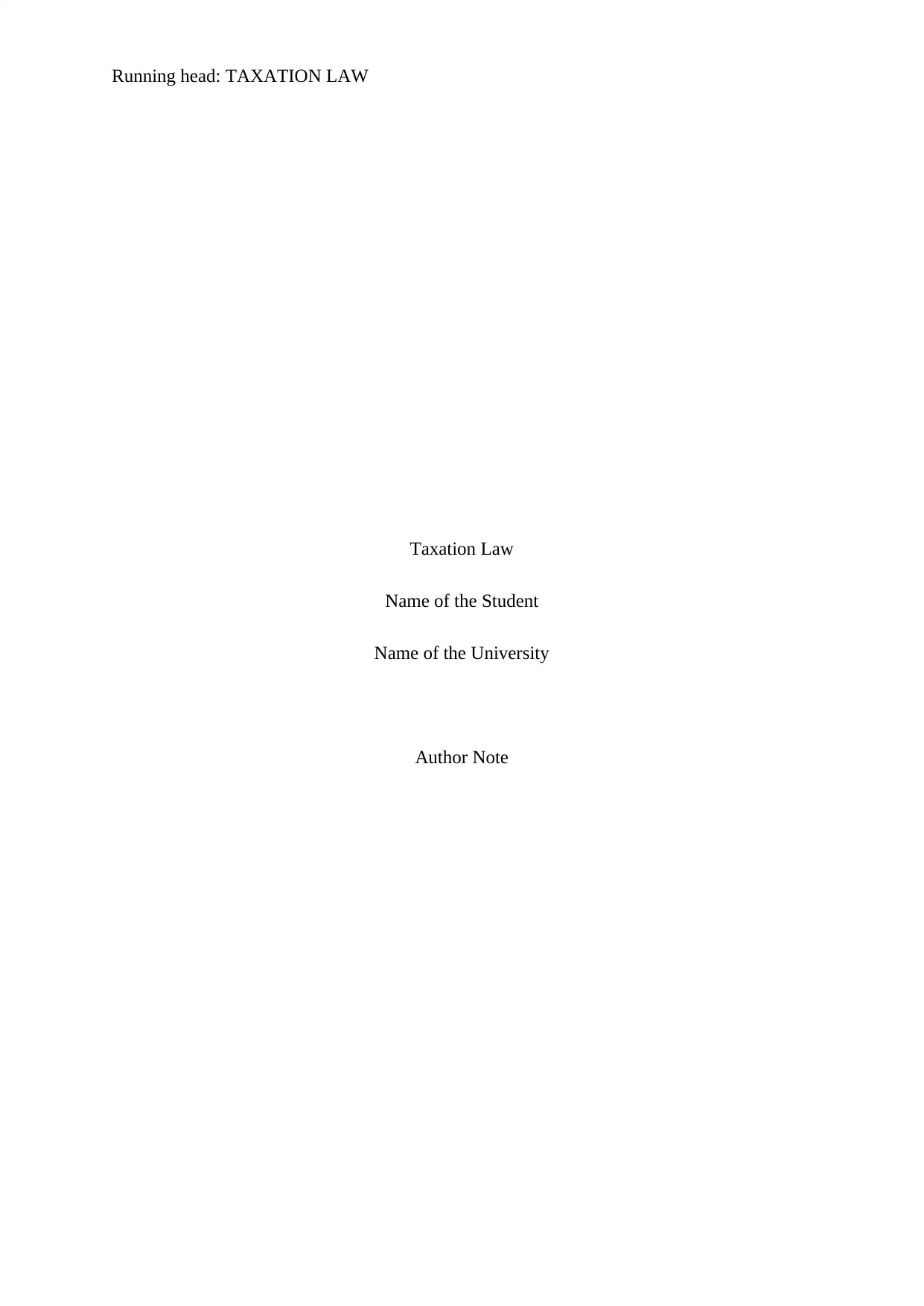
Running head: TAXATION LAW
Taxation Law
Name of the Student
Name of the University
Author Note
Taxation Law
Name of the Student
Name of the University
Author Note
Paraphrase This Document
Need a fresh take? Get an instant paraphrase of this document with our AI Paraphraser
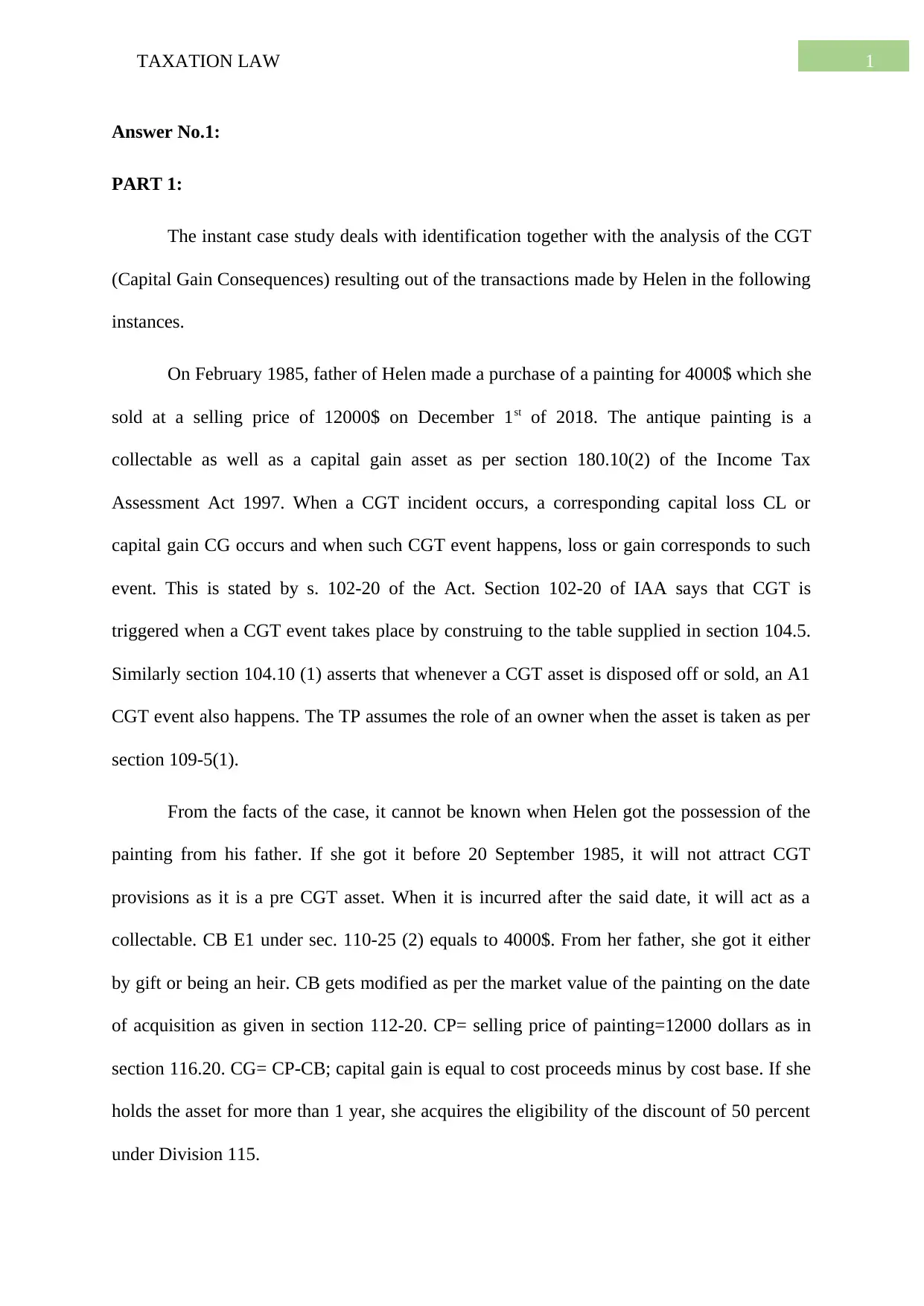
1TAXATION LAW
Answer No.1:
PART 1:
The instant case study deals with identification together with the analysis of the CGT
(Capital Gain Consequences) resulting out of the transactions made by Helen in the following
instances.
On February 1985, father of Helen made a purchase of a painting for 4000$ which she
sold at a selling price of 12000$ on December 1st of 2018. The antique painting is a
collectable as well as a capital gain asset as per section 180.10(2) of the Income Tax
Assessment Act 1997. When a CGT incident occurs, a corresponding capital loss CL or
capital gain CG occurs and when such CGT event happens, loss or gain corresponds to such
event. This is stated by s. 102-20 of the Act. Section 102-20 of IAA says that CGT is
triggered when a CGT event takes place by construing to the table supplied in section 104.5.
Similarly section 104.10 (1) asserts that whenever a CGT asset is disposed off or sold, an A1
CGT event also happens. The TP assumes the role of an owner when the asset is taken as per
section 109-5(1).
From the facts of the case, it cannot be known when Helen got the possession of the
painting from his father. If she got it before 20 September 1985, it will not attract CGT
provisions as it is a pre CGT asset. When it is incurred after the said date, it will act as a
collectable. CB E1 under sec. 110-25 (2) equals to 4000$. From her father, she got it either
by gift or being an heir. CB gets modified as per the market value of the painting on the date
of acquisition as given in section 112-20. CP= selling price of painting=12000 dollars as in
section 116.20. CG= CP-CB; capital gain is equal to cost proceeds minus by cost base. If she
holds the asset for more than 1 year, she acquires the eligibility of the discount of 50 percent
under Division 115.
Answer No.1:
PART 1:
The instant case study deals with identification together with the analysis of the CGT
(Capital Gain Consequences) resulting out of the transactions made by Helen in the following
instances.
On February 1985, father of Helen made a purchase of a painting for 4000$ which she
sold at a selling price of 12000$ on December 1st of 2018. The antique painting is a
collectable as well as a capital gain asset as per section 180.10(2) of the Income Tax
Assessment Act 1997. When a CGT incident occurs, a corresponding capital loss CL or
capital gain CG occurs and when such CGT event happens, loss or gain corresponds to such
event. This is stated by s. 102-20 of the Act. Section 102-20 of IAA says that CGT is
triggered when a CGT event takes place by construing to the table supplied in section 104.5.
Similarly section 104.10 (1) asserts that whenever a CGT asset is disposed off or sold, an A1
CGT event also happens. The TP assumes the role of an owner when the asset is taken as per
section 109-5(1).
From the facts of the case, it cannot be known when Helen got the possession of the
painting from his father. If she got it before 20 September 1985, it will not attract CGT
provisions as it is a pre CGT asset. When it is incurred after the said date, it will act as a
collectable. CB E1 under sec. 110-25 (2) equals to 4000$. From her father, she got it either
by gift or being an heir. CB gets modified as per the market value of the painting on the date
of acquisition as given in section 112-20. CP= selling price of painting=12000 dollars as in
section 116.20. CG= CP-CB; capital gain is equal to cost proceeds minus by cost base. If she
holds the asset for more than 1 year, she acquires the eligibility of the discount of 50 percent
under Division 115.
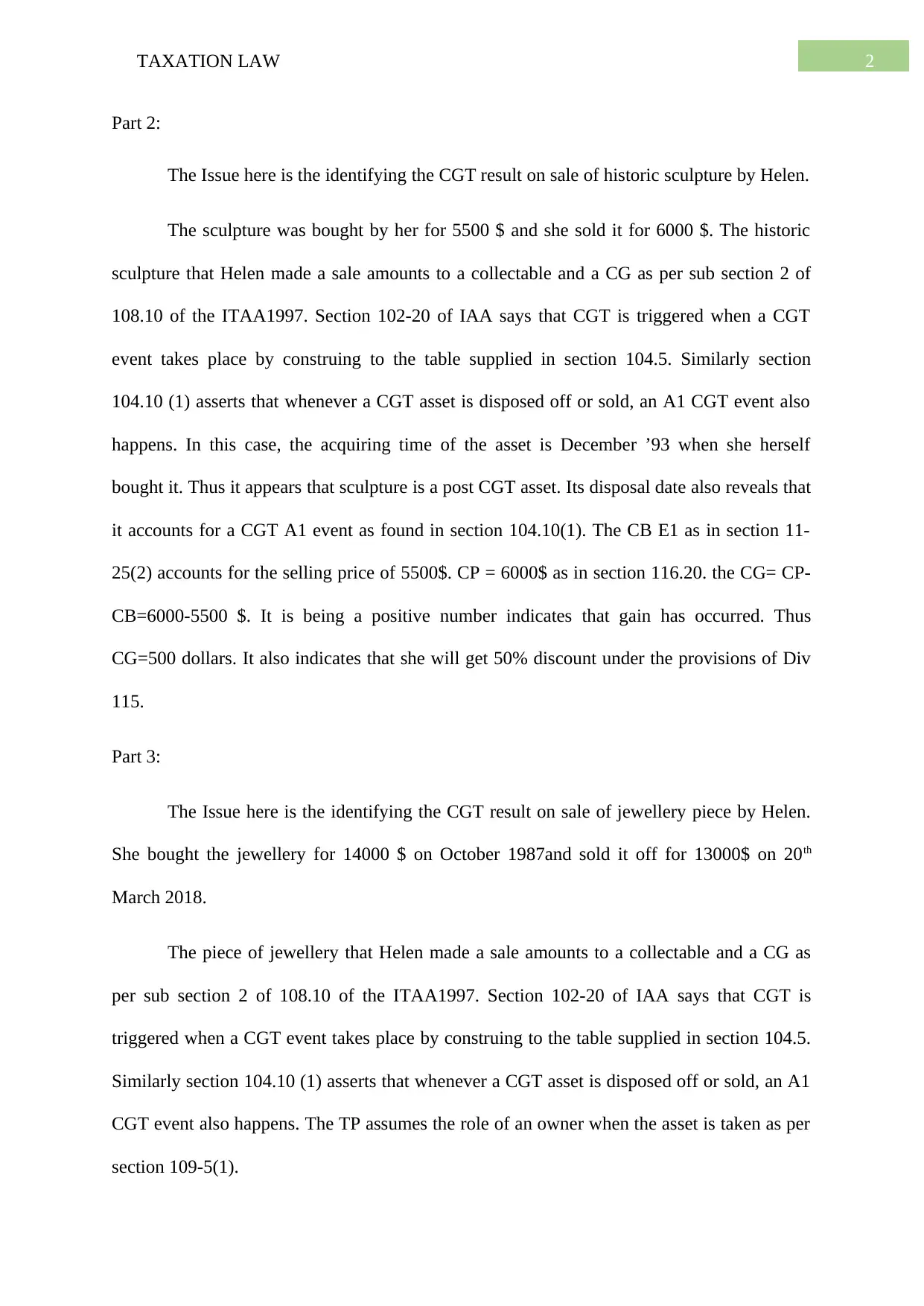
2TAXATION LAW
Part 2:
The Issue here is the identifying the CGT result on sale of historic sculpture by Helen.
The sculpture was bought by her for 5500 $ and she sold it for 6000 $. The historic
sculpture that Helen made a sale amounts to a collectable and a CG as per sub section 2 of
108.10 of the ITAA1997. Section 102-20 of IAA says that CGT is triggered when a CGT
event takes place by construing to the table supplied in section 104.5. Similarly section
104.10 (1) asserts that whenever a CGT asset is disposed off or sold, an A1 CGT event also
happens. In this case, the acquiring time of the asset is December ’93 when she herself
bought it. Thus it appears that sculpture is a post CGT asset. Its disposal date also reveals that
it accounts for a CGT A1 event as found in section 104.10(1). The CB E1 as in section 11-
25(2) accounts for the selling price of 5500$. CP = 6000$ as in section 116.20. the CG= CP-
CB=6000-5500 $. It is being a positive number indicates that gain has occurred. Thus
CG=500 dollars. It also indicates that she will get 50% discount under the provisions of Div
115.
Part 3:
The Issue here is the identifying the CGT result on sale of jewellery piece by Helen.
She bought the jewellery for 14000 $ on October 1987and sold it off for 13000$ on 20th
March 2018.
The piece of jewellery that Helen made a sale amounts to a collectable and a CG as
per sub section 2 of 108.10 of the ITAA1997. Section 102-20 of IAA says that CGT is
triggered when a CGT event takes place by construing to the table supplied in section 104.5.
Similarly section 104.10 (1) asserts that whenever a CGT asset is disposed off or sold, an A1
CGT event also happens. The TP assumes the role of an owner when the asset is taken as per
section 109-5(1).
Part 2:
The Issue here is the identifying the CGT result on sale of historic sculpture by Helen.
The sculpture was bought by her for 5500 $ and she sold it for 6000 $. The historic
sculpture that Helen made a sale amounts to a collectable and a CG as per sub section 2 of
108.10 of the ITAA1997. Section 102-20 of IAA says that CGT is triggered when a CGT
event takes place by construing to the table supplied in section 104.5. Similarly section
104.10 (1) asserts that whenever a CGT asset is disposed off or sold, an A1 CGT event also
happens. In this case, the acquiring time of the asset is December ’93 when she herself
bought it. Thus it appears that sculpture is a post CGT asset. Its disposal date also reveals that
it accounts for a CGT A1 event as found in section 104.10(1). The CB E1 as in section 11-
25(2) accounts for the selling price of 5500$. CP = 6000$ as in section 116.20. the CG= CP-
CB=6000-5500 $. It is being a positive number indicates that gain has occurred. Thus
CG=500 dollars. It also indicates that she will get 50% discount under the provisions of Div
115.
Part 3:
The Issue here is the identifying the CGT result on sale of jewellery piece by Helen.
She bought the jewellery for 14000 $ on October 1987and sold it off for 13000$ on 20th
March 2018.
The piece of jewellery that Helen made a sale amounts to a collectable and a CG as
per sub section 2 of 108.10 of the ITAA1997. Section 102-20 of IAA says that CGT is
triggered when a CGT event takes place by construing to the table supplied in section 104.5.
Similarly section 104.10 (1) asserts that whenever a CGT asset is disposed off or sold, an A1
CGT event also happens. The TP assumes the role of an owner when the asset is taken as per
section 109-5(1).
⊘ This is a preview!⊘
Do you want full access?
Subscribe today to unlock all pages.

Trusted by 1+ million students worldwide
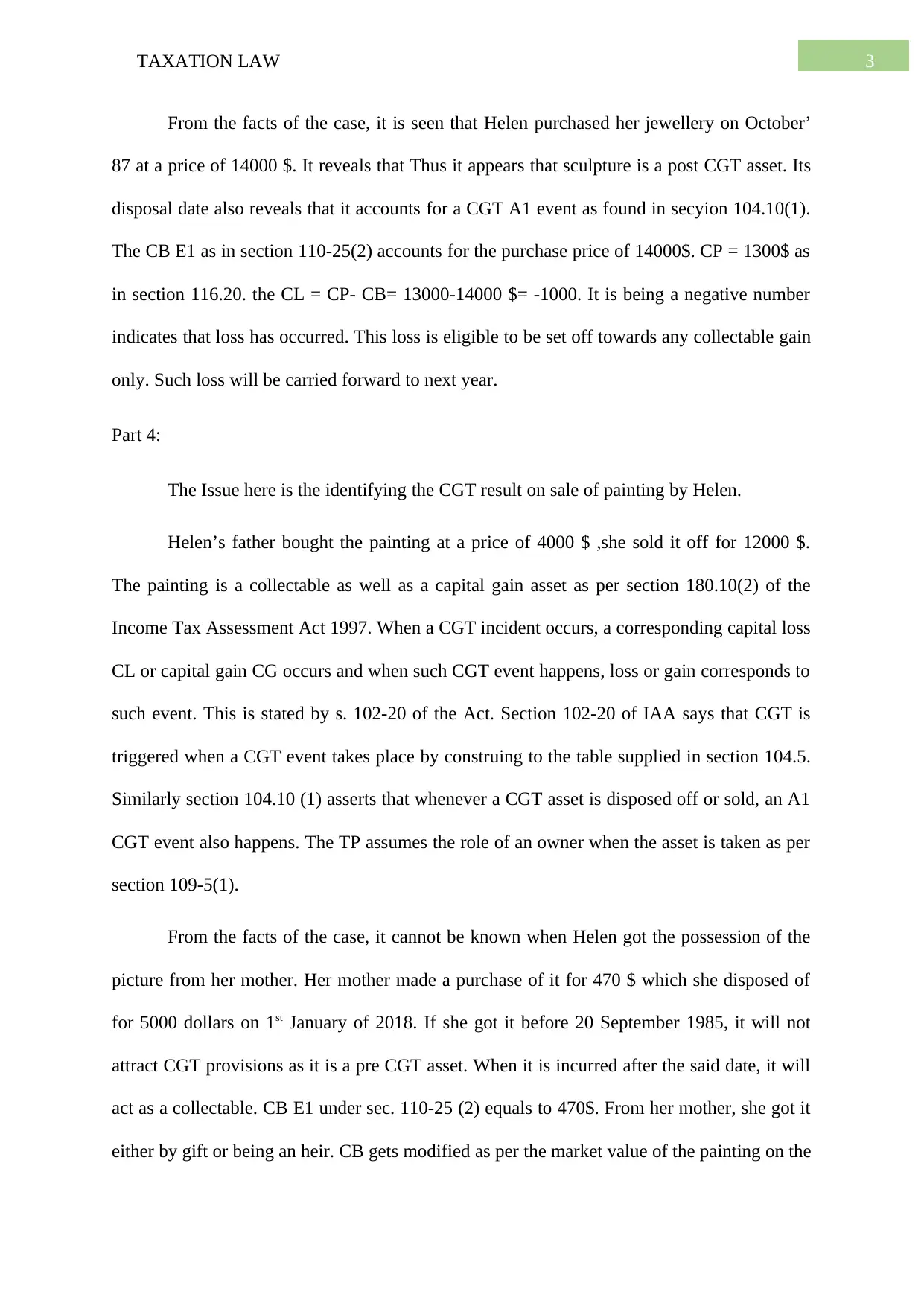
3TAXATION LAW
From the facts of the case, it is seen that Helen purchased her jewellery on October’
87 at a price of 14000 $. It reveals that Thus it appears that sculpture is a post CGT asset. Its
disposal date also reveals that it accounts for a CGT A1 event as found in secyion 104.10(1).
The CB E1 as in section 110-25(2) accounts for the purchase price of 14000$. CP = 1300$ as
in section 116.20. the CL = CP- CB= 13000-14000 $= -1000. It is being a negative number
indicates that loss has occurred. This loss is eligible to be set off towards any collectable gain
only. Such loss will be carried forward to next year.
Part 4:
The Issue here is the identifying the CGT result on sale of painting by Helen.
Helen’s father bought the painting at a price of 4000 $ ,she sold it off for 12000 $.
The painting is a collectable as well as a capital gain asset as per section 180.10(2) of the
Income Tax Assessment Act 1997. When a CGT incident occurs, a corresponding capital loss
CL or capital gain CG occurs and when such CGT event happens, loss or gain corresponds to
such event. This is stated by s. 102-20 of the Act. Section 102-20 of IAA says that CGT is
triggered when a CGT event takes place by construing to the table supplied in section 104.5.
Similarly section 104.10 (1) asserts that whenever a CGT asset is disposed off or sold, an A1
CGT event also happens. The TP assumes the role of an owner when the asset is taken as per
section 109-5(1).
From the facts of the case, it cannot be known when Helen got the possession of the
picture from her mother. Her mother made a purchase of it for 470 $ which she disposed of
for 5000 dollars on 1st January of 2018. If she got it before 20 September 1985, it will not
attract CGT provisions as it is a pre CGT asset. When it is incurred after the said date, it will
act as a collectable. CB E1 under sec. 110-25 (2) equals to 470$. From her mother, she got it
either by gift or being an heir. CB gets modified as per the market value of the painting on the
From the facts of the case, it is seen that Helen purchased her jewellery on October’
87 at a price of 14000 $. It reveals that Thus it appears that sculpture is a post CGT asset. Its
disposal date also reveals that it accounts for a CGT A1 event as found in secyion 104.10(1).
The CB E1 as in section 110-25(2) accounts for the purchase price of 14000$. CP = 1300$ as
in section 116.20. the CL = CP- CB= 13000-14000 $= -1000. It is being a negative number
indicates that loss has occurred. This loss is eligible to be set off towards any collectable gain
only. Such loss will be carried forward to next year.
Part 4:
The Issue here is the identifying the CGT result on sale of painting by Helen.
Helen’s father bought the painting at a price of 4000 $ ,she sold it off for 12000 $.
The painting is a collectable as well as a capital gain asset as per section 180.10(2) of the
Income Tax Assessment Act 1997. When a CGT incident occurs, a corresponding capital loss
CL or capital gain CG occurs and when such CGT event happens, loss or gain corresponds to
such event. This is stated by s. 102-20 of the Act. Section 102-20 of IAA says that CGT is
triggered when a CGT event takes place by construing to the table supplied in section 104.5.
Similarly section 104.10 (1) asserts that whenever a CGT asset is disposed off or sold, an A1
CGT event also happens. The TP assumes the role of an owner when the asset is taken as per
section 109-5(1).
From the facts of the case, it cannot be known when Helen got the possession of the
picture from her mother. Her mother made a purchase of it for 470 $ which she disposed of
for 5000 dollars on 1st January of 2018. If she got it before 20 September 1985, it will not
attract CGT provisions as it is a pre CGT asset. When it is incurred after the said date, it will
act as a collectable. CB E1 under sec. 110-25 (2) equals to 470$. From her mother, she got it
either by gift or being an heir. CB gets modified as per the market value of the painting on the
Paraphrase This Document
Need a fresh take? Get an instant paraphrase of this document with our AI Paraphraser
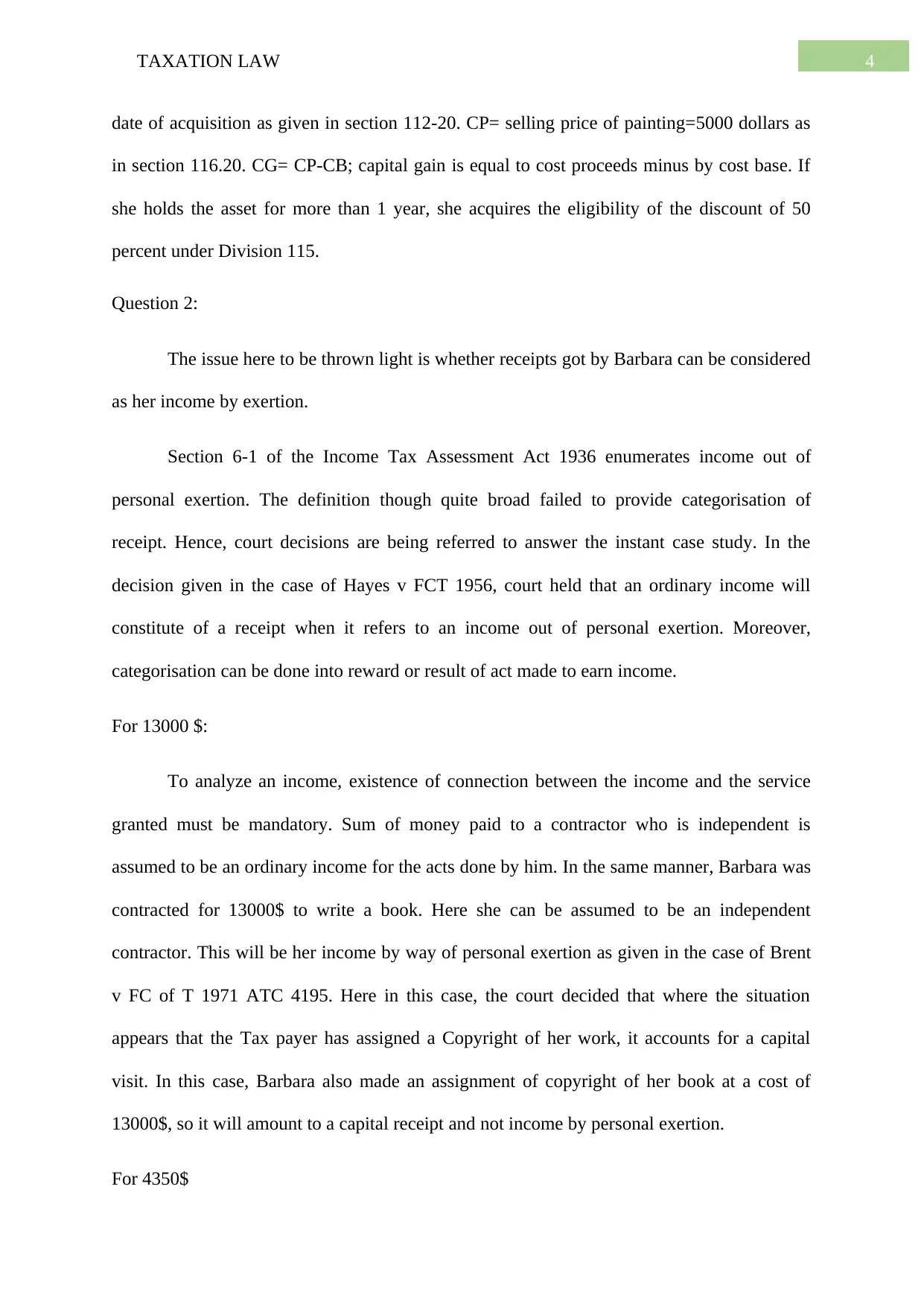
4TAXATION LAW
date of acquisition as given in section 112-20. CP= selling price of painting=5000 dollars as
in section 116.20. CG= CP-CB; capital gain is equal to cost proceeds minus by cost base. If
she holds the asset for more than 1 year, she acquires the eligibility of the discount of 50
percent under Division 115.
Question 2:
The issue here to be thrown light is whether receipts got by Barbara can be considered
as her income by exertion.
Section 6-1 of the Income Tax Assessment Act 1936 enumerates income out of
personal exertion. The definition though quite broad failed to provide categorisation of
receipt. Hence, court decisions are being referred to answer the instant case study. In the
decision given in the case of Hayes v FCT 1956, court held that an ordinary income will
constitute of a receipt when it refers to an income out of personal exertion. Moreover,
categorisation can be done into reward or result of act made to earn income.
For 13000 $:
To analyze an income, existence of connection between the income and the service
granted must be mandatory. Sum of money paid to a contractor who is independent is
assumed to be an ordinary income for the acts done by him. In the same manner, Barbara was
contracted for 13000$ to write a book. Here she can be assumed to be an independent
contractor. This will be her income by way of personal exertion as given in the case of Brent
v FC of T 1971 ATC 4195. Here in this case, the court decided that where the situation
appears that the Tax payer has assigned a Copyright of her work, it accounts for a capital
visit. In this case, Barbara also made an assignment of copyright of her book at a cost of
13000$, so it will amount to a capital receipt and not income by personal exertion.
For 4350$
date of acquisition as given in section 112-20. CP= selling price of painting=5000 dollars as
in section 116.20. CG= CP-CB; capital gain is equal to cost proceeds minus by cost base. If
she holds the asset for more than 1 year, she acquires the eligibility of the discount of 50
percent under Division 115.
Question 2:
The issue here to be thrown light is whether receipts got by Barbara can be considered
as her income by exertion.
Section 6-1 of the Income Tax Assessment Act 1936 enumerates income out of
personal exertion. The definition though quite broad failed to provide categorisation of
receipt. Hence, court decisions are being referred to answer the instant case study. In the
decision given in the case of Hayes v FCT 1956, court held that an ordinary income will
constitute of a receipt when it refers to an income out of personal exertion. Moreover,
categorisation can be done into reward or result of act made to earn income.
For 13000 $:
To analyze an income, existence of connection between the income and the service
granted must be mandatory. Sum of money paid to a contractor who is independent is
assumed to be an ordinary income for the acts done by him. In the same manner, Barbara was
contracted for 13000$ to write a book. Here she can be assumed to be an independent
contractor. This will be her income by way of personal exertion as given in the case of Brent
v FC of T 1971 ATC 4195. Here in this case, the court decided that where the situation
appears that the Tax payer has assigned a Copyright of her work, it accounts for a capital
visit. In this case, Barbara also made an assignment of copyright of her book at a cost of
13000$, so it will amount to a capital receipt and not income by personal exertion.
For 4350$
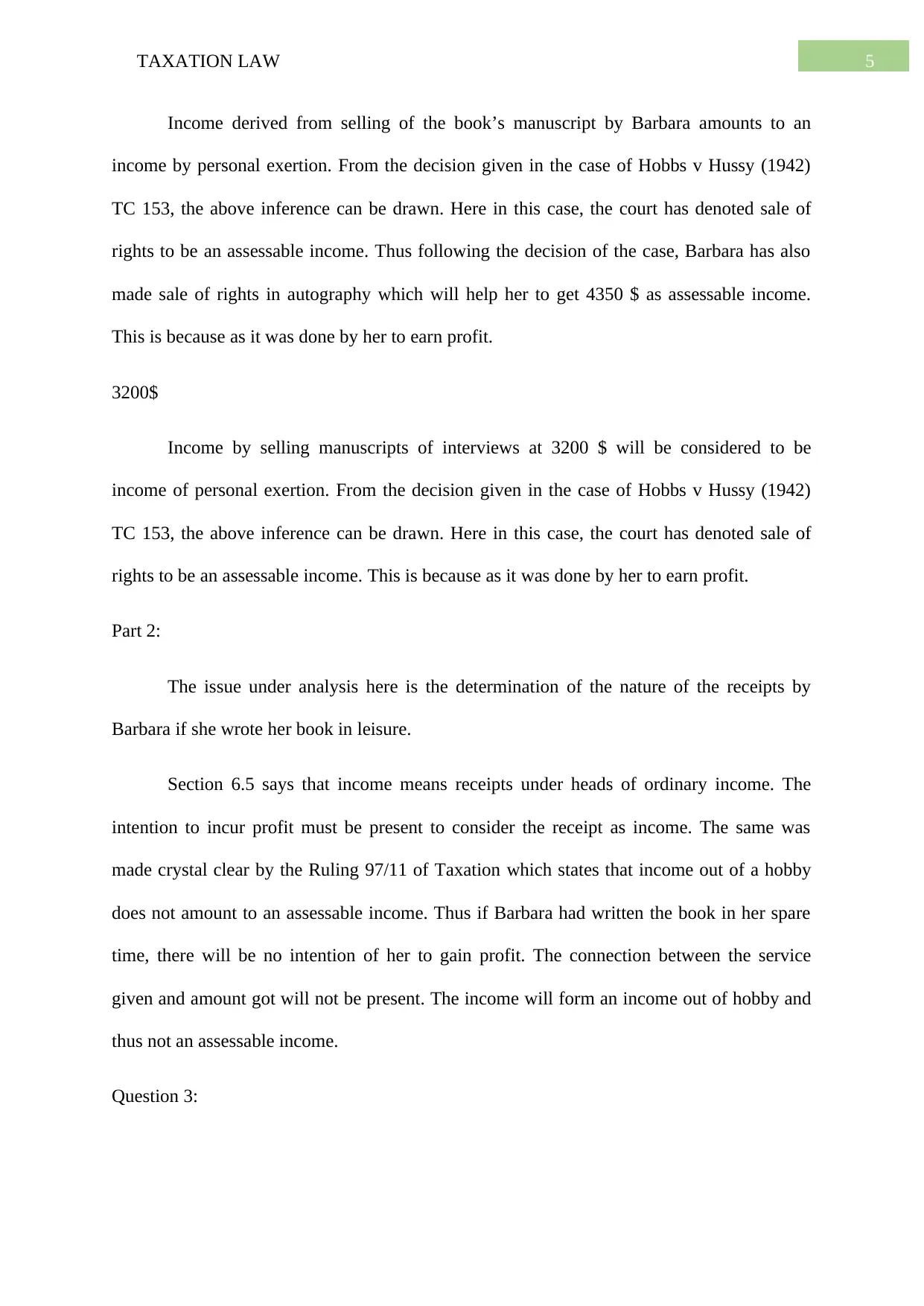
5TAXATION LAW
Income derived from selling of the book’s manuscript by Barbara amounts to an
income by personal exertion. From the decision given in the case of Hobbs v Hussy (1942)
TC 153, the above inference can be drawn. Here in this case, the court has denoted sale of
rights to be an assessable income. Thus following the decision of the case, Barbara has also
made sale of rights in autography which will help her to get 4350 $ as assessable income.
This is because as it was done by her to earn profit.
3200$
Income by selling manuscripts of interviews at 3200 $ will be considered to be
income of personal exertion. From the decision given in the case of Hobbs v Hussy (1942)
TC 153, the above inference can be drawn. Here in this case, the court has denoted sale of
rights to be an assessable income. This is because as it was done by her to earn profit.
Part 2:
The issue under analysis here is the determination of the nature of the receipts by
Barbara if she wrote her book in leisure.
Section 6.5 says that income means receipts under heads of ordinary income. The
intention to incur profit must be present to consider the receipt as income. The same was
made crystal clear by the Ruling 97/11 of Taxation which states that income out of a hobby
does not amount to an assessable income. Thus if Barbara had written the book in her spare
time, there will be no intention of her to gain profit. The connection between the service
given and amount got will not be present. The income will form an income out of hobby and
thus not an assessable income.
Question 3:
Income derived from selling of the book’s manuscript by Barbara amounts to an
income by personal exertion. From the decision given in the case of Hobbs v Hussy (1942)
TC 153, the above inference can be drawn. Here in this case, the court has denoted sale of
rights to be an assessable income. Thus following the decision of the case, Barbara has also
made sale of rights in autography which will help her to get 4350 $ as assessable income.
This is because as it was done by her to earn profit.
3200$
Income by selling manuscripts of interviews at 3200 $ will be considered to be
income of personal exertion. From the decision given in the case of Hobbs v Hussy (1942)
TC 153, the above inference can be drawn. Here in this case, the court has denoted sale of
rights to be an assessable income. This is because as it was done by her to earn profit.
Part 2:
The issue under analysis here is the determination of the nature of the receipts by
Barbara if she wrote her book in leisure.
Section 6.5 says that income means receipts under heads of ordinary income. The
intention to incur profit must be present to consider the receipt as income. The same was
made crystal clear by the Ruling 97/11 of Taxation which states that income out of a hobby
does not amount to an assessable income. Thus if Barbara had written the book in her spare
time, there will be no intention of her to gain profit. The connection between the service
given and amount got will not be present. The income will form an income out of hobby and
thus not an assessable income.
Question 3:
⊘ This is a preview!⊘
Do you want full access?
Subscribe today to unlock all pages.

Trusted by 1+ million students worldwide
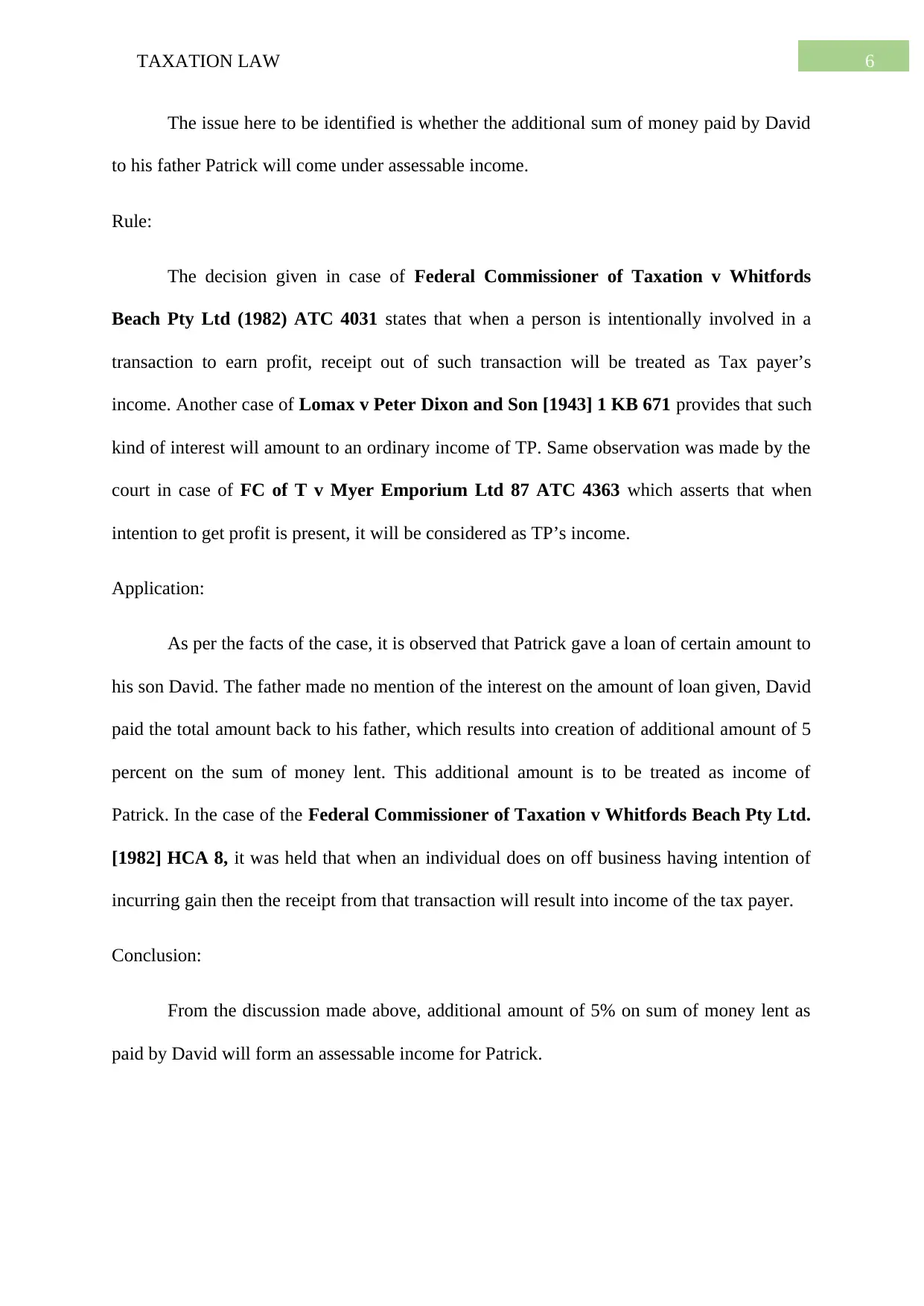
6TAXATION LAW
The issue here to be identified is whether the additional sum of money paid by David
to his father Patrick will come under assessable income.
Rule:
The decision given in case of Federal Commissioner of Taxation v Whitfords
Beach Pty Ltd (1982) ATC 4031 states that when a person is intentionally involved in a
transaction to earn profit, receipt out of such transaction will be treated as Tax payer’s
income. Another case of Lomax v Peter Dixon and Son [1943] 1 KB 671 provides that such
kind of interest will amount to an ordinary income of TP. Same observation was made by the
court in case of FC of T v Myer Emporium Ltd 87 ATC 4363 which asserts that when
intention to get profit is present, it will be considered as TP’s income.
Application:
As per the facts of the case, it is observed that Patrick gave a loan of certain amount to
his son David. The father made no mention of the interest on the amount of loan given, David
paid the total amount back to his father, which results into creation of additional amount of 5
percent on the sum of money lent. This additional amount is to be treated as income of
Patrick. In the case of the Federal Commissioner of Taxation v Whitfords Beach Pty Ltd.
[1982] HCA 8, it was held that when an individual does on off business having intention of
incurring gain then the receipt from that transaction will result into income of the tax payer.
Conclusion:
From the discussion made above, additional amount of 5% on sum of money lent as
paid by David will form an assessable income for Patrick.
The issue here to be identified is whether the additional sum of money paid by David
to his father Patrick will come under assessable income.
Rule:
The decision given in case of Federal Commissioner of Taxation v Whitfords
Beach Pty Ltd (1982) ATC 4031 states that when a person is intentionally involved in a
transaction to earn profit, receipt out of such transaction will be treated as Tax payer’s
income. Another case of Lomax v Peter Dixon and Son [1943] 1 KB 671 provides that such
kind of interest will amount to an ordinary income of TP. Same observation was made by the
court in case of FC of T v Myer Emporium Ltd 87 ATC 4363 which asserts that when
intention to get profit is present, it will be considered as TP’s income.
Application:
As per the facts of the case, it is observed that Patrick gave a loan of certain amount to
his son David. The father made no mention of the interest on the amount of loan given, David
paid the total amount back to his father, which results into creation of additional amount of 5
percent on the sum of money lent. This additional amount is to be treated as income of
Patrick. In the case of the Federal Commissioner of Taxation v Whitfords Beach Pty Ltd.
[1982] HCA 8, it was held that when an individual does on off business having intention of
incurring gain then the receipt from that transaction will result into income of the tax payer.
Conclusion:
From the discussion made above, additional amount of 5% on sum of money lent as
paid by David will form an assessable income for Patrick.
Paraphrase This Document
Need a fresh take? Get an instant paraphrase of this document with our AI Paraphraser
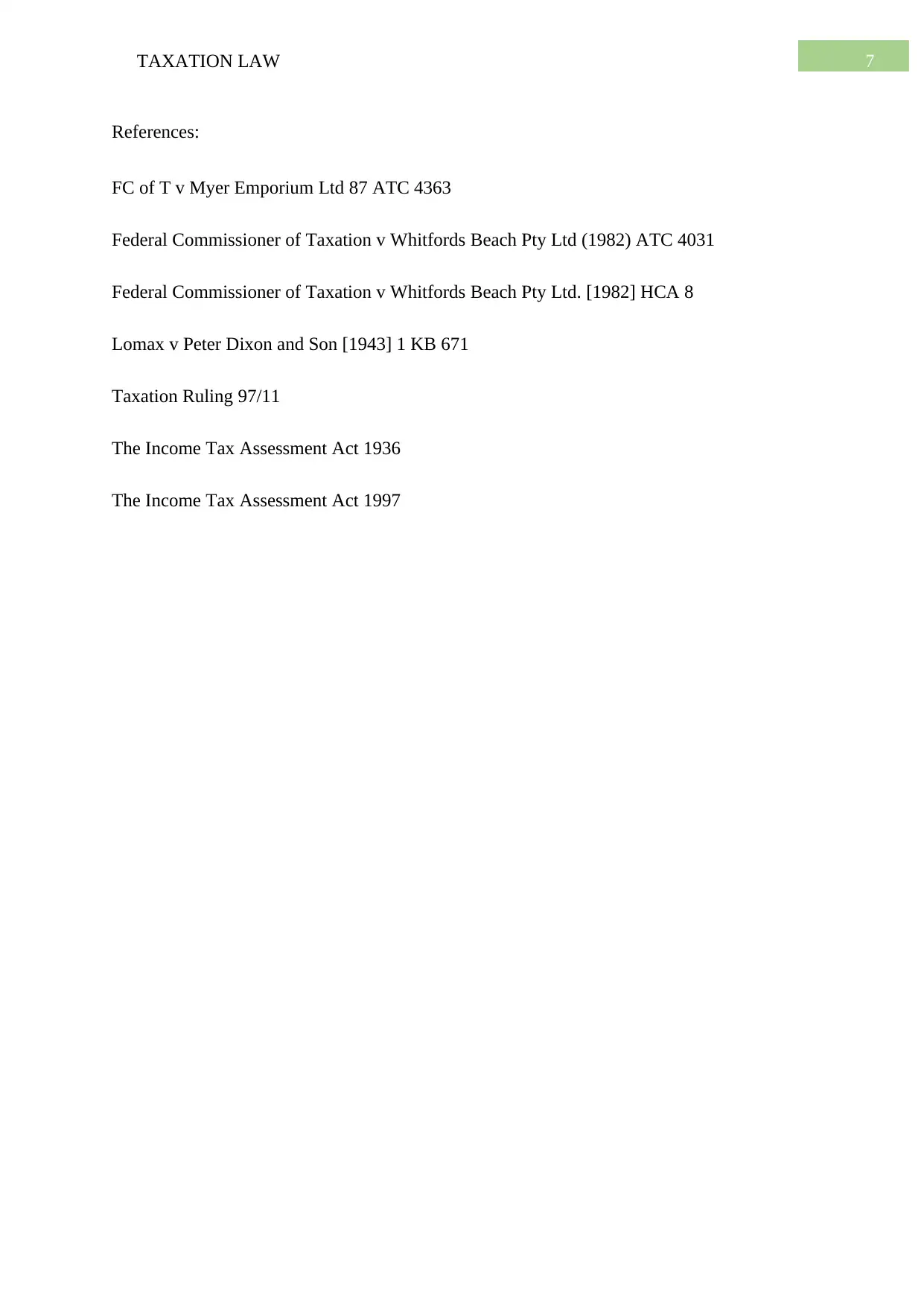
7TAXATION LAW
References:
FC of T v Myer Emporium Ltd 87 ATC 4363
Federal Commissioner of Taxation v Whitfords Beach Pty Ltd (1982) ATC 4031
Federal Commissioner of Taxation v Whitfords Beach Pty Ltd. [1982] HCA 8
Lomax v Peter Dixon and Son [1943] 1 KB 671
Taxation Ruling 97/11
The Income Tax Assessment Act 1936
The Income Tax Assessment Act 1997
References:
FC of T v Myer Emporium Ltd 87 ATC 4363
Federal Commissioner of Taxation v Whitfords Beach Pty Ltd (1982) ATC 4031
Federal Commissioner of Taxation v Whitfords Beach Pty Ltd. [1982] HCA 8
Lomax v Peter Dixon and Son [1943] 1 KB 671
Taxation Ruling 97/11
The Income Tax Assessment Act 1936
The Income Tax Assessment Act 1997
1 out of 8
Related Documents
Your All-in-One AI-Powered Toolkit for Academic Success.
+13062052269
info@desklib.com
Available 24*7 on WhatsApp / Email
![[object Object]](/_next/static/media/star-bottom.7253800d.svg)
Unlock your academic potential
Copyright © 2020–2025 A2Z Services. All Rights Reserved. Developed and managed by ZUCOL.





